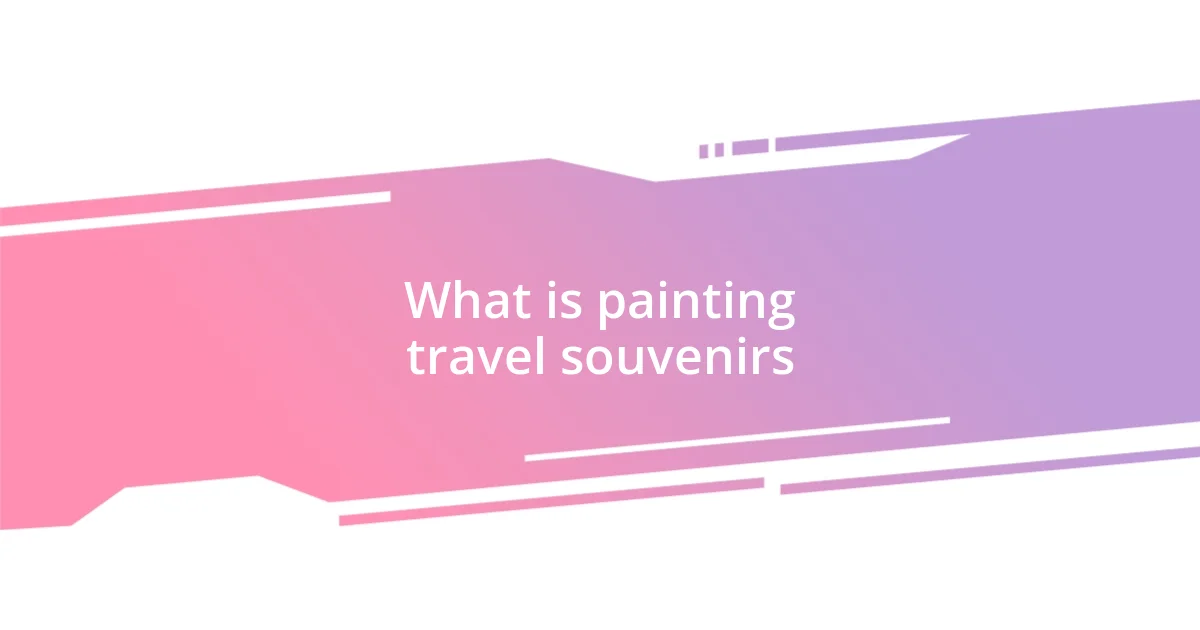Key takeaways:
- Painting travel souvenirs serves as a creative and emotional diary, allowing artists to capture and reflect on their travel experiences.
- Utilizing quality tools and techniques, such as layering and dry brushing, enhances the artistic process and improves outcomes.
- Displaying painted souvenirs thoughtfully can enhance their narrative and create engaging visual experiences for viewers.

What is painting travel souvenirs
Painting travel souvenirs is a creative way to capture the essence of your journeys. It’s not just about slapping paint on a canvas; it’s about distilling your experiences into a tangible memory. I remember vividly standing on the cliffs of Santorini, brush in hand, as the sun dipped below the horizon. How could I encapsulate that breathtaking view? The vivid colors, the warmth in the air—they all demanded to be immortalized.
For me, painting travel souvenirs also becomes a sort of emotional diary. Each stroke represents a moment, a conversation, or even a feeling that came alive during my travels. When I painted a small scene of a bustling market in Marrakech, it brought back the scents of spices and the laughter of local vendors. Isn’t it incredible how a simple piece of art can transport you back to a specific place and time, evoking emotions you thought were long gone?
Ultimately, painting travel souvenirs is about expressing the stories behind our travels. Whether it’s the joy of discovering a hidden gem or the serenity found in a quiet beach, each painting reflects a piece of me. This practice invites us to reflect—what stories do our travel memories hold? By painting them, we don’t just remember; we create lasting legacies of our adventures, linking our past with our present.

Benefits of painting souvenirs
Painting souvenirs offers a unique blend of creativity and nostalgia. When I took up this practice, I found that each brushstroke rekindled vivid memories. For instance, while working on a piece inspired by a sunset in Bali, I was transported back to the peaceful sound of waves crashing against the shore. It’s like reliving a moment, every time I glance at my finished painting.
The benefits extend beyond personal enjoyment as well. Painting can improve focus and mindfulness, allowing the artist to fully immerse in their experiences. Here are some advantages I’ve noticed:
- Emotional Connection: Each painting serves as a tangible reminder of a cherished memory.
- Creative Expression: It provides a canvas for expressing feelings and experiences that words alone might not convey.
- Stress Relief: Engaging in this artistic process can be a calming escape from daily routines.
- Skill Development: Every piece painted sharpens your artistic abilities, allowing for continuous growth.
- Cultural Appreciation: Through the act of painting, I’ve gained a deeper appreciation for the cultures and landscapes I’ve explored.

Tools and materials for painting
When it comes to painting travel souvenirs, selecting the right tools and materials is crucial. From my experience, the quality of your brushes and paints can significantly impact the final outcome. I always find myself reaching for a set of fine brushes for detail work, especially when I want to capture the delicate patterns of a Moroccan tile. It’s fascinating how the right tools can transform your artistic vision into reality.
Another essential aspect is the surface you’ll be painting on. I’ve experimented with various mediums, but I often prefer watercolor paper for its texture and ability to blend colors seamlessly. During a trip to Italy, I painted on canvas, and though it was a different feel, I yearned for that softness of watercolors that reminded me of my childhood art classes. This relationship with surfaces can really enhance the depth of what you want to convey in your paintings.
Lastly, I believe having a portable palette is essential for artists who enjoy painting while traveling. Investing in a good quality palette not only helps in color mixing but makes it easy to carry your art supplies wherever you go. On my journey to Thailand, I packed a compact travel kit, and it allowed me to set up my workspace anywhere, whether by the beach or in a local café. It’s these little conveniences that encourage spontaneity in your art, making each painting an adventure of its own.
| Tool/Material | Description |
|---|---|
| Brushes | Various sizes are crucial for detail and blending. |
| Paints | Watercolors or acrylics depending on desired effect. |
| Palette | A portable palette helps in color mixing on the go. |
| Canvas/Paper | Select based on your medium; I prefer watercolor paper. |

Techniques for painting effectively
When it comes to painting effectively, I’ve discovered that layering is one of the most powerful techniques. When I paint, I often start with a light wash to establish the foundational colors of a piece, much like setting the mood of a scene. This method doesn’t just lay the groundwork; it adds depth and dimension to my work. Have you ever noticed how an initial light base often leads to unexpected surprises as the layers build?
Another technique I highly value is the use of dry brushing, which adds texture and character to a painting. During a recent painting session depicting the rocky cliffs of Santorini, I used dry brushing to create the roughness of the rocks. It felt incredible to watch the paint catch on the texture of the paper, bringing my subject to life. This tactile approach offers a hands-on connection to the artwork that I find exciting.
Lastly, I can’t overstate the importance of taking breaks while painting. It may seem counterintuitive, but stepping away from the canvas for a moment allows me to come back with fresh eyes. I remember feeling frustrated with a painting of a bustling market in Marrakech; I decided to take a short stroll. Upon returning, I was able to see the areas that needed refinement more clearly, which ultimately enhanced the overall quality of my work. Trust me, sometimes the best inspiration can strike when you least expect it!

Choosing your travel subjects
Choosing the right subjects for travel paintings can be a deeply personal experience. I remember standing in a quiet corner of a bustling market in Marrakech, feeling an overwhelming urge to capture the energy around me. The vibrant spices, colorful fabrics, and the expressions of the vendors all told a story. How do you decide what to paint? For me, it’s all about the moments that resonate with my experiences and emotions.
It’s fascinating how some subjects may stir a sense of nostalgia or adventure in us. On my recent trip to Greece, I found myself drawn to the sunlit streets of an old village. The interplay of light and shadow on the whitewashed walls transported me back to childhood summers spent in my grandmother’s home. This connection can make a distinction between a mere image and a heartfelt piece of art that speaks to the viewer.
I often advise fellow artists to seek out the lesser-known scenes—the quiet alleyways, the fleeting smiles of locals, or even the mundane elements of daily life. I once captured a solitary fisherman pulling in his net during sunrise in a tiny Italian harbor. The moment was serene and intimate, revealing the beauty of simplicity. These kinds of subjects can evoke powerful feelings in your audience, allowing them to travel back in time or to places they’ve never been. What subjects will you choose to bring your travels alive?

Displaying your painted souvenirs
Displaying your painted souvenirs is an art form in itself. I’ve discovered that the way you showcase your artwork can enhance its beauty and tell a deeper story. For instance, I once decided to frame a painting of a serene sunrise over the Italian coastline using a reclaimed wood frame. Not only did it complement the colors of the painting, but it also tied in a rustic charm that echoed the coastal village vibe.
I also like to create mini galleries in my home. By clustering my travel paintings in one space, I invite visitors to take a visual journey with me. I remember arranging a series of cityscapes from Paris to Barcelona on a single wall. Each piece sparked conversations about my travels and the stories behind them. How do you think your displays could encourage others to connect with your experiences?
Lastly, I find that using different heights when displaying my pieces can add an interesting dimension to the arrangement. One time, I placed a smaller painting of a vibrant market scene on a wooden easel next to a larger landscape on the wall. This layered effect drew the eye in and made the entire display feel dynamic. Have you thought about the impact of varying heights in your own display? It can transform a simple setup into an engaging visual narrative.














